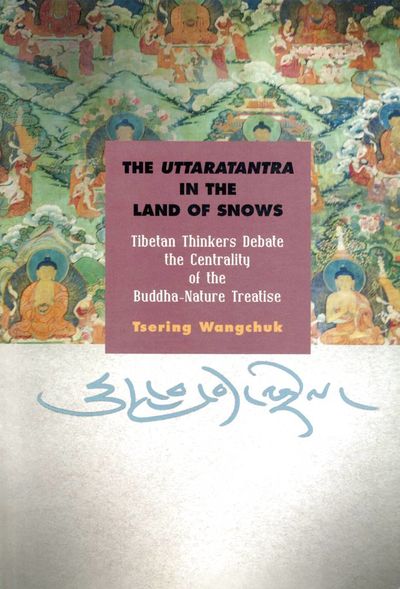|
|
| Line 12: |
Line 12: |
|
| |
|
| The advantage of Wangchuk's historical frame is that all assertions are placed in easy context of an opponent or supporter's writing, thus reminding the reader that buddha-nature theory in Tibet is an ongoing conversation, a debate between the two fundamental doctrinal poles of positive and negative descriptions of the ultimate. | | The advantage of Wangchuk's historical frame is that all assertions are placed in easy context of an opponent or supporter's writing, thus reminding the reader that buddha-nature theory in Tibet is an ongoing conversation, a debate between the two fundamental doctrinal poles of positive and negative descriptions of the ultimate. |
| | |BookToc=*{{i|Acknowledgments|}} |
| | *{{i|Introduction|}} |
| | |
| | *{{i|General Remarks|}} |
| | *{{i|Textual Historical Background|}} |
| | |
| | *{{i|Part I. Early Period: Kadam Thinkers Rescue the Treatise|}} |
| | **{{i|1. Rise of the Uttaratantra in Tibet: Early Kadam Scholars Revitalize the Newly Discovered Indian Exegesis|}} |
| | ***{{i|Introduction|}} |
| | ***{{i|Ngok and Chapa on the Pervasive Nature of the Buddha-Body|}} |
| | ***{{i|Ngok and Chapa on Definitive or Provisional Nature in the Uttaratantra |}} |
| | ***{{i|Ngok and Chapa on the Uttaratantra as a Last Wheel Treatise |}} |
| | ***{{i|Buddha-Element as a Conceived Object|}} |
| | ***{{i|Ngok and Chapa Differ on Emphasis|}} |
| | ***{{i|Conclusion|}} |
| | **{{i|2. Sowing Seeds for Future Debate: Dissenters and Adherents|}} |
| | ***{{i|Introduction |}} |
| | ***{{i|Sapen, the Dissenter |}} |
| | ***{{i|Rikrel, the Third Karmapa, and Sangpu Lodrö Defend the Uttaratantra |}} |
| | ***{{i|Rinchen Yeshé’s Proto Other-Emptiness Presentation of the Uttaratantra, and Butön’s Reply|}} |
| | ***{{i|Conclusion|}} |
| | *{{i|Part II. The Pinnacle Period: the Other-Emptiness Interpretation Spreads |}} |
| | **{{i|3. Other-Emptiness Tradition: The Uttaratantra in Dölpopa’s Works|}} |
| | ***{{i|Introduction|}} |
| | ***{{i|Predominance of the Last Wheel Scriptures|}} |
| | ***{{i|Is the Uttaratantra a Cittamātra Text or a Madhyamaka Text?|}} |
| | ***{{i|Classification of Cittamātra|}} |
| | ***{{i|Classification of Madhyamaka|}} |
| | ***{{i|Conclusion|}} |
| | **{{i|4. The Uttaratantra in Fourteenth-Century Tibet|}} |
| | ***{{i|Introduction |}} |
| | ***{{i|Sazang Follows in His Master’s Footsteps|}} |
| | ***{{i|Two Fourteenth-Century Kadam Masters’ Uttaratantra Commentaries |}} |
| | ***{{i|Longchenpa’s View on the Uttaratantra|}} |
| | ***{{i|Conclusion|}} |
| | *{{i|Part III. The Argumentation Period: Self-Emptiness Proponents criticize Other-Emptiness Approach |}} |
| | **{{i|5. Challenges to the Purely Definitive Nature of the Uttaratantra: Zhalu Thinkers Criticize Dölpopa |}} |
| | ***{{i|Introduction|}} |
| | ***{{i|Butön’s Ornament |}} |
| | ***{{i|Dratsépa’s Commentary|}} |
| | ***{{i|Conclusion|}} |
| | **{{i|6. Challenges to the Supremacy of the Uttaratantra: Rendawa and Tsongkhapa on Tathāgata-essence Literature |}} |
| | ***{{i|Introduction|}} |
| | ***{{i|Rendawa on the Uttaratantra and the Tathāgata-Essence Literature|}} |
| | ***{{i|Tsongkhapa on the Uttaratantra and the Tathāgata-Essence Literature|}} |
| | ***{{i|Conclusion|}} |
| | **7. {{i|Gyeltsap’s Commentary on the Uttaratantra: A Critique of Dölpopa’s Interpretation of Tathāgata-essence Literature|}} |
| | ***{{i|Introduction|}} |
| | ***{{i|Middle Wheel and Last Wheel Teachings|}} |
| | ***{{i|Definitive Meaning and Provisional Meaning|}} |
| | ***{{i|Self-Emptiness and Other-Emptiness|}} |
| | ***{{i|Conclusion|}} |
| | *{{i|Conclusion|}} |
| | *{{i|General Remarks|}} |
| | *{{i|Completing the Cycle|}} |
| | *{{i|Notes|}} |
| | *{{i|Bibliography|}} |
| | *{{i|Tibetan Language Works Cited|}} |
| | *{{i|English Language Works Cited|}} |
| | *{{i|Index|}} |
| |AddRelatedTab=No | | |AddRelatedTab=No |
| |QuotesTabContent={{GetBookQuotes}} | | |QuotesTabContent={{GetBookQuotes}} |
| |PostStatus=Needs Copy Editing | | |PostStatus=Needs Copy Editing |
| }} | | }} |



